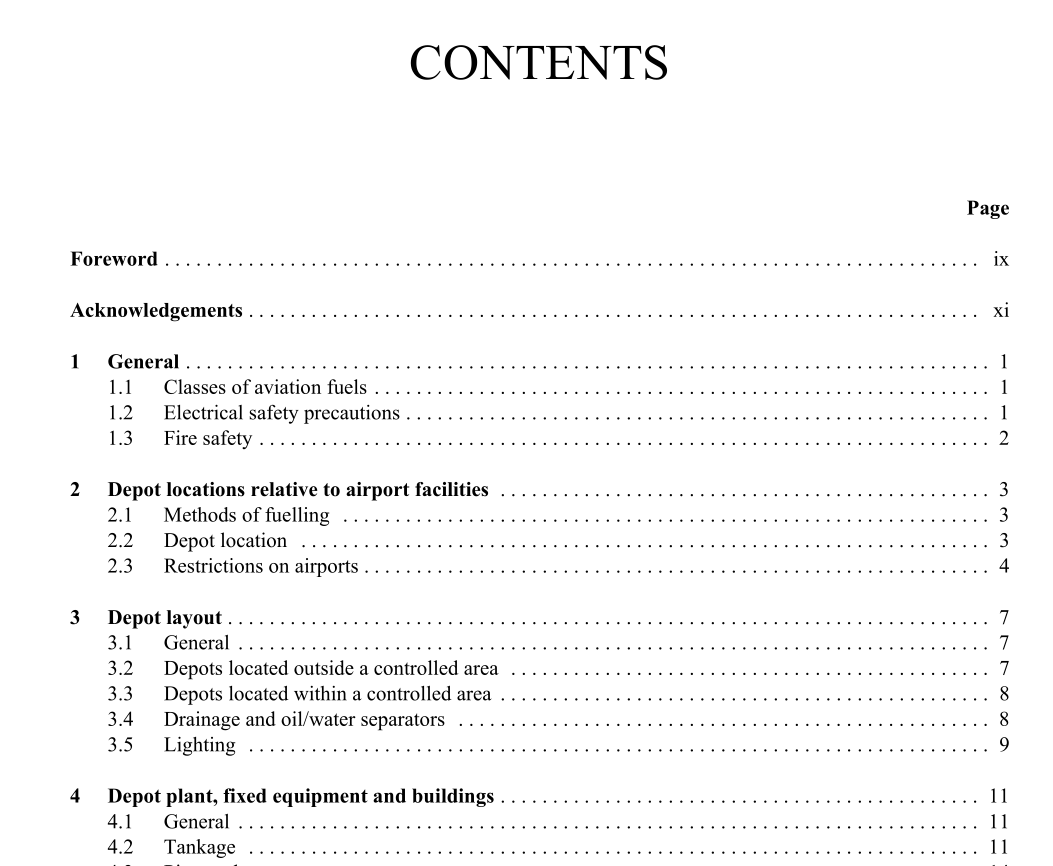API IP RP 1540 pdf download

API IP RP 1540 pdf download.DESIGN, CONSTRUCTION, OPERATION AND MAINTENANCE OF AVIATION FUELLING FACILITIES
1.1.3 General classification The classification of aviation fuels, which will divide fuels into classes based on flash point and other considerations, will lead to determining safety separation distance of tanks, the type of tank and its fittings, handling precautions, etc. when designing and operating facilities. The classification of aviation fuels is not a simple matter and in all cases local or national standards should be adhered to. (See Annex B-2 and Annex D.) When handling petroleum products in hot climates or in circumstances where the products are artificially heated, special consideration of the effect of these circumstances should always be taken as they may change the classification of the product being handled. The requirements of local or national standards should be adhered to. 1.2 ELECTRICAL SAFETY PRECAUTIONS 1.2.1 General Local or national electrical safety codes, and other publications, set out in detail the special precautions needed to safeguard against the risk of fire or explosion due to the use of electrical current and lightning. (See Annex B-2 for a listing of some national standards.) Due consideration should be given to the requirements/ guidance contained therein.
2.1 METHODS OF FUELLING
Depending on the scale of operation at an airport, the usual fuelling methods used can be mobile fuellers, a hydrant system, a fixed dispensing unit or an underground chamber system. Where mobile fuellers are employed, the airport depot facilities allow for the fuel required by the aircraft to be pumped from the storage tank into fuellers which then proceed to the aircraft where the fuel is delivered. In the case of hydrant fuelling, the facilities provide for the fuel to be pumped directly from the airport fuel depot storage tanks to the aircraft parking apron by means of pipelines and then transferred from the hydrant pit(s) installed there into the aircraft via hydrant servicer(s). In cases where for any reason main airport stocks of fuel are located at such a distance that a direct fuelling service is impracticable, intermediate tankage for this purpose may be provided at a satellite or forward fuel depot conveniently close to the fuelling area. A satellite depot would usually be supplied by pipeline(s) from the main depot. The use of fixed dispensing units is normally limited to smaller airfields where light aircraft are fuelled. These may be the sole source of fuel or they may supplement mobile fuellers. They may take the form of a cabinet supplied from an underground tank, a remotely positioned above-ground tank, or in the case of a modular unit, from an integrally mounted horizontal tank. It is normal practice for the cabinet or dispensing unit to be fitted with a suitable type of filter, a hose reel, a meter, a bonding cable and a safety shutoff/deadman device. The aircraft requiring fuel taxis to the fuelling area. Such facilities should be located in an area away from normal taxiing areas in order to minimise the risk of damage. A further system, to be found extensively on military bases and some commercial airports, is the underground chamber system whereby the equipment normally found on a hydrant servicer is located in a pit adjacent to the aircraft parking/fuelling position.
2.2 DEPOT LOCATION
The selection of the best site for an airport fuel depot is governed firstly by the restrictions which are necessary to ensure the safety of aircraft operations (see 2.3) and secondly by the efficiency in fuelling aircraft. Depots from which mobile fuelling is carried out preferably should be located so as to give ready and easy access to the fuelling area by mobile fuellers, making as little use as possible of public highways and airport roads open to general traffic. Where practicable, the necessity for mobile fuellers to cross runways or their approaches should be avoided. When a number of fuelling areas exist on an airport a compromise location, or more than one depot, may be necessary. Hydrant systems are subject to hydraulic shock pressures or surge pressures when supply to the aircraft is shut off. Hydrant system surge pressures are dependent upon product velocity in the pipeline and the hydrant configuration and length in relation to valve closure time. (See Section 5.) The aircraft is protected from these surge pressures by devices on the hydrant servicer, and surge pressures in hydrant systems, whatever the length, can be catered for within the design of the system. Therefore, although ideally the distance between the airport fuel depot and the fuelling area should be as short as possible this is not an overriding consideration. Where surge pressure generation within the hydrant system could lead to component damage, the use of surge suppressing equipment should be considered. When it is not possible to locate the airport fuel depot near to the fuelling area then a satellite area, with office and parking space for fuelling equipment, to facilitate supervision of fuelling operations, should be considered. Supplies of fuel may arrive at the airport by pipeline, road tanker, rail tank car or water-borne transport and these factors should be taken into consideration in locating the airport fuel depot. (See Annex B-2 for relevant sources of information.)









